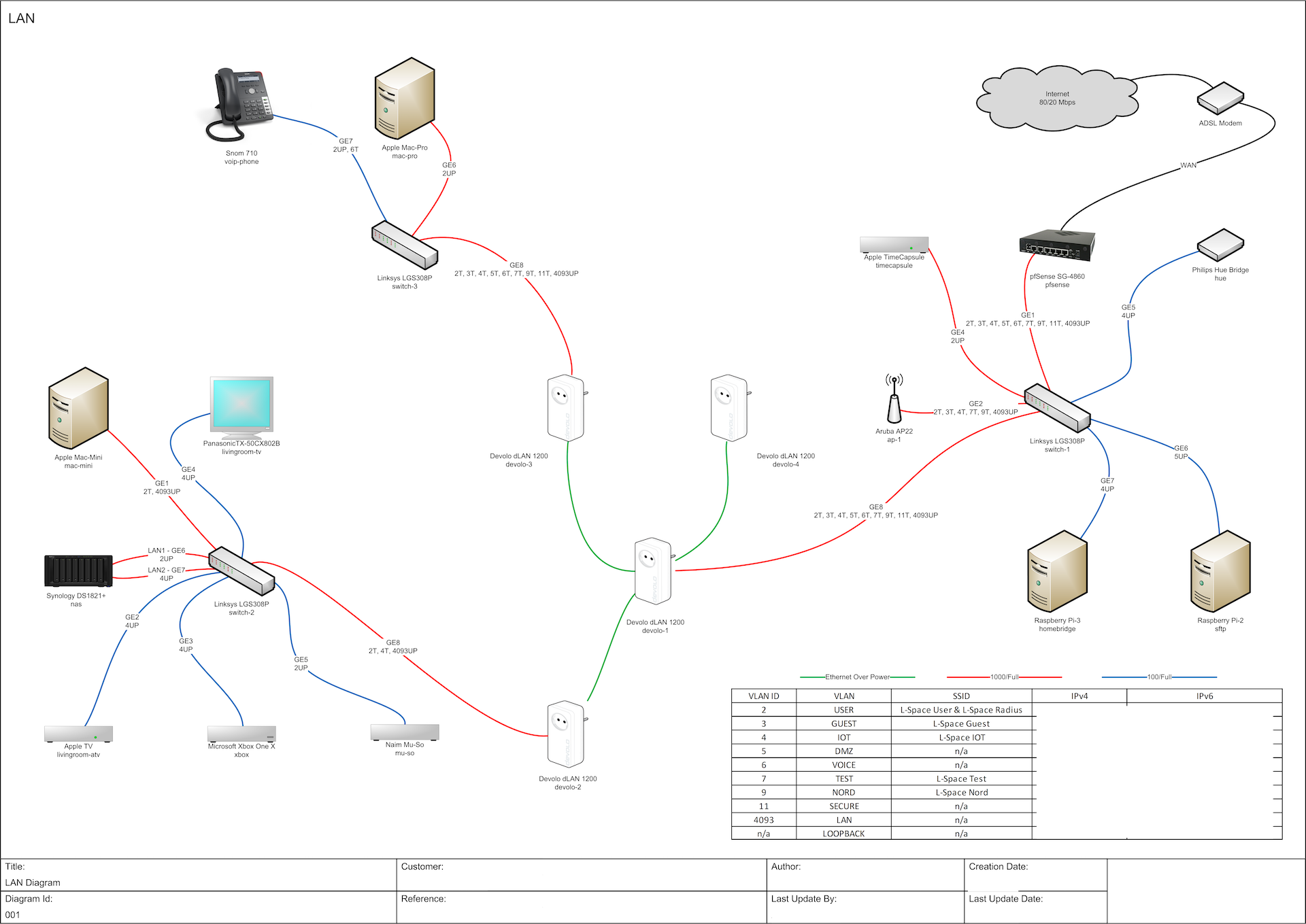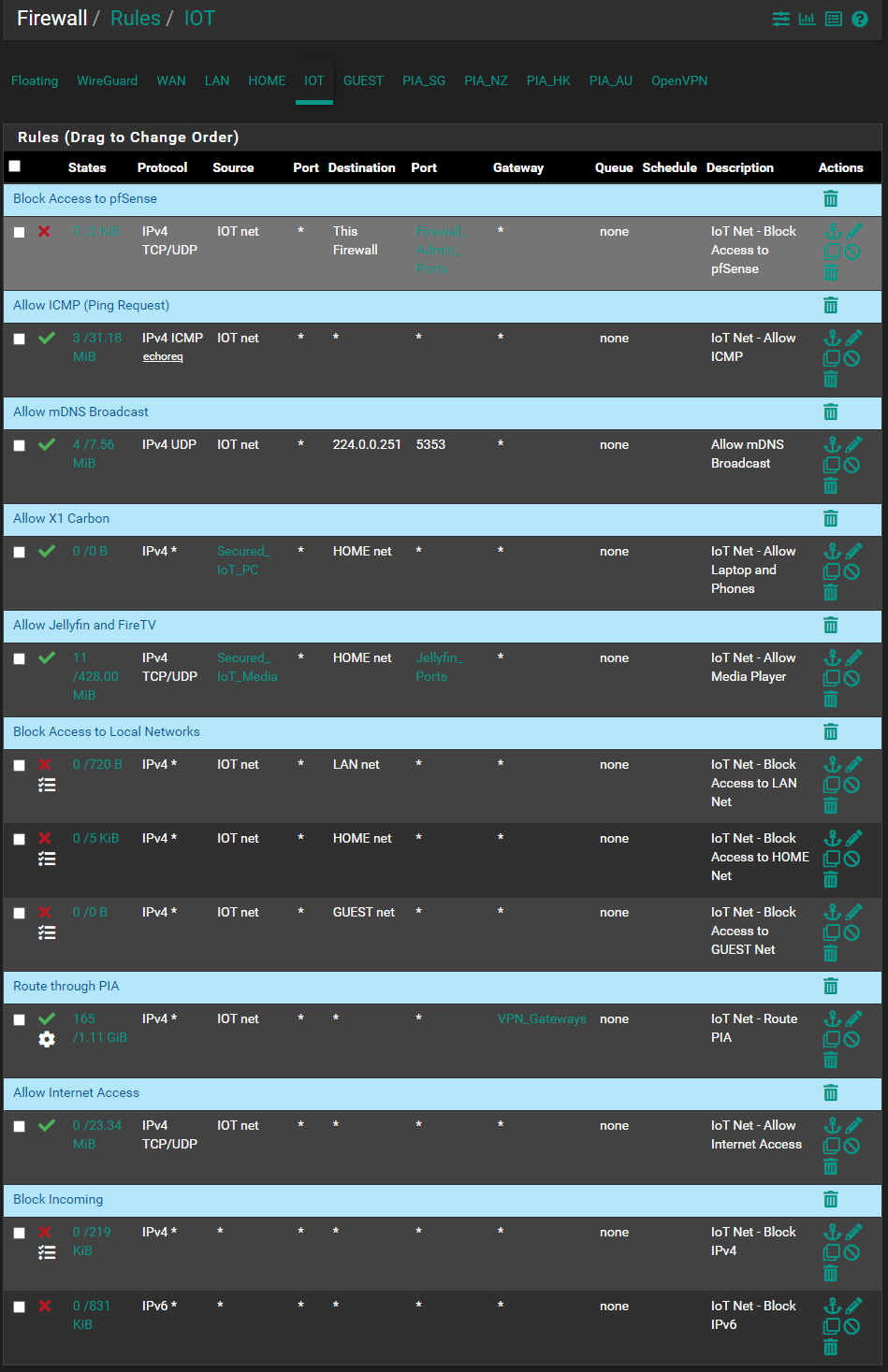Access Jellyfin server on different subnet
-
@stephenw10 looks like he is limiting to ports in a a jellyfin alias as well. So icmp wouldn't work even if it was a any any rule vs just tcp/udp.
Since there is zero evaluations on that rule - either he has the wrong ports in that alias, or its not actually populated at all. But if it had the jellyfin http port, he should be able to access it. Or atleast show a evaluation on it vs 0/0
Possible he had an existing state going out his vpn connection?
I would create a IPv4 any any rule to your jellyfin IP, and make sure all states are clear in your state table to your jellyfin IP.. And then you should be able to ping it an access it via http or https.
-
@swust said in Access Jellyfin server on different subnet:
@nogbadthebad running on Windows PC. i have all the Jellyfin related ports open but still can't access. would you have any link to resource re: what you did with the NAS and SMB share with Infuse?
My NAS has 4 ethernet interfaces, the main one is on the USER vlan ( vlan 2 ), an additional interface is connected to the IOT vlan ( vlan 4 ) and there are firewall rules on the NAS to only enable SMB access for the AppleTV devices, so traffic doesn't traverse the pfSense firewall.

-
If you set the protocol to anything other than tcp and/or udp the ports are removed anyway.

-
@stephenw10 true ;)
-
my jellyfin server IP is 192.168.20.10. I have the allow ICMP rule at the top that i didn't include in the screenshot above. the jellyfin port alias includes the http/https port 8096/8920.
Since I can't use the FireTV to ping out and diagnose, I use a Laptop as client on IoT VLAN to test if I can access Jellyfin server on HOME VLAN. so I redo the rules to allow all traffic from IoT VLAN to HOME VLAN , deactivate all the block rules and VPN routing. also reset states. reboot.

HOME VLAN
Jellyfin Server can ping all devices on IoT VLAN (including the FireTV client!), but can't ping my Laptop that's on the IoT VLAN.IoT VLAN
The Laptop can ping all devices on IoT VLAN, the pfsense addresses on both LAN (192.168.10.1) and HOME VLAN (192.168.20.1), but can't ping my PCs on HOME VLAN.I thought this should be straightforward but it doesn't work! I suspect there's something on my Laptop. Is there any troubleshooting steps I can go through to figure this out?
Thanks all @stephenw10 @darcey @NogBadTheBad @johnpoz for your help! amazing community support!
-
My understanding is the firewall operates upon traffic entering an interface from outside. So, either your rules are blocking echoreq entering via IOT or echoreply returning via HOME. That or some policy based rule is sending the traffic elsewhere at some point on its journey through the firewall.
It may help to log some default drops:
Temporarily add an explicit block/log rule at the end of the firewall rules for both HOME and IOT interfaces. See if/where ICMP traffic (or other traffic of interest) may be getting blocked. Or I think you can turn on default drop logging somewhere. You can then filter the firewall log view. -
@swust said in Access Jellyfin server on different subnet:
Jellyfin Server can ping all devices on IoT VLAN (including the FireTV client!), but can't ping my Laptop that's on the IoT VLAN.
Are you sure your laptop normally responds to ICMP or other protocols for that matter? May be it is in some public network mode.
-
@swust said in Access Jellyfin server on different subnet:
i didn't include in the screenshot above.
Why? If you want help - you need to show us your rules. Also helpful leaving the interface the rules are on in the screenshot as well..
@darcey said in Access Jellyfin server on different subnet:
Are you sure your laptop normally responds to ICMP
This could be it sure - windows firewall out of the box is not going to answer ping from another network.
Also any return traffic is allowed by the firewall via the state.. So doesn't matter what rules are on the destination network, you could have zero rules and answer to some traffic would be allowed by pfsense via the state it created when it allowed the traffic. While icmp is actually a stateless protocol - pfsense does create a state to track it.
Here is me pinging something in dmz network from my lan network.

I do not allow my dmz talk to my lan, but lan can talk to dmz - so pinging dmz works, as long as the devices in the dmz answer.
Notice the rule on dmz that specifically rejects talking to other rfc1918 networks, yet my ping to it works just fine.

-
I figured it out! having read all your comments, i somehow thought of my ESET firewall on the jellyfin server. it's what been rejecting connection. Jellyfin now can access the server, and my Laptop can also access the server. my initial pfsense firewall rules were fine. the full set below, work flawlessly.

Thanks a lot for all your inputs, much appreciated!
-
@swust said in Access Jellyfin server on different subnet:
I figured it out! having read all your comments, i somehow thought of my ESET firewall on the jellyfin server. it's what been rejecting connection.
Aha! Good news.
Does this mean you've also successfully played back content, served up by jellyfin, on your firetv yet? And done so without doing the SSDP/autodiscovery proxy thing for the IoT LAN?
Then I might get one of these firetv devices ;-) -
@swust what exactly are you pointing devices in your iot for dns.. They sure can't be using pfsense since your blocking that access in first rule. Ah unless you don't have 53 in the ports list on that rule.
Your also sending everything out your vpn, so saying allow internet below that is pointless. so even dns would need to go out your vpn..
-
@darcey said in Access Jellyfin server on different subnet:
@swust said in Access Jellyfin server on different subnet:
I figured it out! having read all your comments, i somehow thought of my ESET firewall on the jellyfin server. it's what been rejecting connection.
Aha! Good news.
Does this mean you've also successfully played back content, served up by jellyfin, on your firetv yet? And done so without doing the SSDP/autodiscovery proxy thing for the IoT LAN?
Then I might get one of these firetv devices ;-)yes I can play everything from the server on both my FireTV and Cube. I am running Kodi on both, I can set the IP of the server directly via Jellyfin addon for Kodi. I'm not sure if discovery would work. I tested on my phone and upon installing, it doesn't automatically search the same way it usually does. But I can simply input the server IP address and it works fine.
-
@johnpoz said in Access Jellyfin server on different subnet:
@swust what exactly are you pointing devices in your iot for dns.. They sure can't be using pfsense since your blocking that access in first rule. Ah unless you don't have 53 in the ports list on that rule.
I'm not sure about this, I didn't specifically changed anything. I don't have port 53 in the first rule, only 22 and 443. Should I though?
I am using DNS Forwarder rather than Resolver, the ISP in Indonesia has some sort of censorship so we have to use their specific DNS otherwise it won't work.
Your also sending everything out your vpn, so saying allow internet below that is pointless. so even dns would need to go out your vpn..
Makes sense. I didn't think about this, but I need to keep this, sometimes I need to turn the VPN off because some local sites doesn't work, or PIA is extremely slow.
-
@swust
Thanks. I'd like a compact media player that doesn't rely soley on SSDP (like the smart tv does). That would make IoT/server separation cleaner IMO. -
@swust said in Access Jellyfin server on different subnet:
sometimes I need to turn the VPN off because some local sites doesn't work
Better way would rule above the vpn rule to allow those sites, or rule above that has specific device not use the vpn etc..
-
@darcey said in Access Jellyfin server on different subnet:
@swust
Thanks. I'd like a compact media player that doesn't rely soley on SSDP (like the smart tv does). That would make IoT/server separation cleaner IMO.If you're an Apple type, I'd recommend an Apple TV with the Infuse app.
https://firecore.com/infuse
-
@nogbadthebad Thanks for the suggestion. It's a bit more than my needs justify right now.
I'm looking for a basic (cheap compact) consumer playback device that can:- Access a DNLA media server from a typed URL. No reliance on autodiscover.
- Support media navigation from a tv remote (via CEC passthrough).
- Amazon prime video support a bonus.
I guess this is something like Kodi on a raspberry pi, but I wonder if firetv stick will manage it.
Currently I spin up minidlna containers on network where needed and mount the media library RO in the container. But the OPs setup made me curious.
-
I guess this is something like Kodi on a raspberry pi, but I wonder if firetv stick will manage it.
i've been using Cube and FireTV with Kodi via SMB shares for years and it's been very good. only recently discovered Jellyfin, which is nicer since my library is centralized, and the trakt.tv addon is great to managed watched status. Media navigation with TV remote worked flawlessly on my Samsung TV, though to exit Kodi, gotta go through the kodi menu rather than just using the back button on the TV remote.
-
@johnpoz said in Access Jellyfin server on different subnet:
@swust said in Access Jellyfin server on different subnet:
sometimes I need to turn the VPN off because some local sites doesn't work
Better way would rule above the vpn rule to allow those sites, or rule above that has specific device not use the vpn etc..
thought about that but those sites are few and random, so i thought it's easier to just kill the VPN temporarily if i need to access to sites which is very infrequent.
-
@swust even if infrequent, once you create the rule for those things you don't want to use the vpn for.. Its a one time thing, and then you don't have to worry about disable vpn any time you need to access those. That is what I would do - but hey you do you.. Either way works.